
A Dyson sphere is a hypothetical megastructure that encompasses a star and captures a large percentage of its solar power output. The concept is a thought experiment that attempts to imagine how a spacefaring civilization would meet its energy requirements once those requirements exceed what can be generated from the home planet's resources alone. Because only a tiny fraction of a star's energy emissions reaches the surface of any orbiting planet, building structures encircling a star would enable a civilization to harvest far more energy.
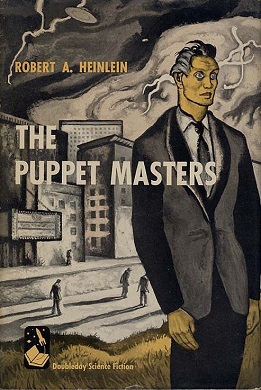
The Puppet Masters is a 1951 science fiction novel by American writer Robert A. Heinlein, in which American secret agents battle parasitic invaders from outer space. It was originally serialized in Galaxy Science Fiction.

Citizen of the Galaxy is a science fiction novel by American writer Robert A. Heinlein, originally serialized in Astounding Science Fiction and published in hardcover in 1957 as one of the Heinlein juveniles by Scribner's. The story is heavily influenced by Rudyard Kipling's Kim.

Methuselah's Children is a science fiction novel by American writer Robert A. Heinlein. Originally serialized in Astounding Science Fiction in the July, August, and September 1941 issues, it was expanded into a full-length novel in 1958. The novel is part of Heinlein's Future History series of stories. It introduces the Howard families, a fictional group of people who achieved long lifespans through selective breeding.

"Third from the Sun" is episode 14 of the American television anthology series The Twilight Zone. It is based on a short story of the same name by Richard Matheson which first appeared in the first issue of the magazine Galaxy Science Fiction in October 1950.

Woman in the Moon is a German science fiction silent film that premiered 15 October 1929 at the UFA-Palast am Zoo cinema in Berlin to an audience of 2,000. It is often considered to be one of the first "serious" science fiction films. It was directed by Fritz Lang, and written by his wife Thea von Harbou, based on her 1928 novel The Rocket to the Moon. It was released in the US as By Rocket to the Moon and in the UK as Girl in the Moon. The basics of rocket travel were presented to a mass audience for the first time by this film, including the use of a multi-stage rocket. The film was shot between October 1928 and June 1929 at the UFA studios in Neubabelsberg near Berlin.
My Teacher Is an Alien is a four-book science fiction children's book series authored by Bruce Coville. The titles include:

Inconstant Moon is a science fiction short story collection by American author Larry Niven that was published in 1973. "Inconstant Moon" is also a 1971 short story that is included in the collection. The title refers to "O, swear not by the moon, th' inconstant moon", a quote from the balcony scene in William Shakespeare's Romeo and Juliet. The collection was assembled from the US collections The Shape of Space and All the Myriad Ways.

Cities in Flight is a four-volume series of science fiction novels and short stories by American writer James Blish, originally published between 1950 and 1962, which were first known collectively as the "Okie" novels. The series features entire cities that are able to fly through space using an anti-gravity device, the spindizzy. The stories cover roughly two thousand years, from the very near future to the end of the universe. One story, "Earthman, Come Home", won a Retro Hugo Award in 2004 for Best Novelette. Since 1970, the primary edition has been the omnibus volume first published in paperback by Avon Books. Over the years James Blish made many changes to these stories in response to points raised in letters from readers.

The hypothetical particles tachyons have inspired many occurrences of in fiction. The use of the word in science fiction dates back at least to 1970 when James Blish's Star Trek novel Spock Must Die! incorporated tachyons into an ill-fated transporter experiment.
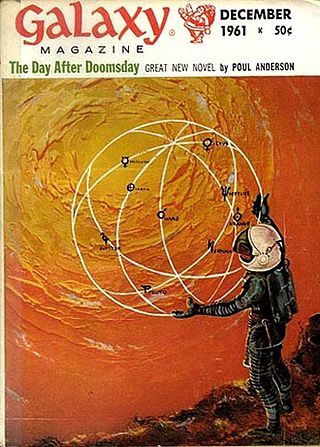
After Doomsday is a science fiction novel by American writer Poul Anderson. It was published as a complete novel in 1962, having been serialized as The Day after Doomsday in the magazine Galaxy, between December 1961 and February 1962.

Star Guard is a science fiction novel by American writer Andre Norton, published in 1955 by Harcourt, Brace & Company. It is an example of military science fiction, based on European ancient history.

The Stars Are Ours! is a 1954 science fiction novel by American writer Andre Norton. It describes the first interstellar voyage, undertaken to escape the tyranny that rules the Earth. Norton wrote a sequel, Star Born, which was published in 1957.
These works were written or edited by the American fiction writer Andre Norton. Before 1960 she used the pen name Andrew North several times and, jointly with Grace Allen Hogarth, Allen Weston once.

Sargasso of Space is a science fiction novel by American writer Andre Norton, written under the alternate pseudonym "Andrew North". It was published in 1955 by Gnome Press in an edition of 4,000 copies.

Galactic Derelict is a science fiction novel by American writer Andre Norton, the second in her Time Traders series. It was first published in 1959, and as of 2012, had been reprinted in eight editions. It is part of Norton's Forerunner universe.

The Defiant Agents is a science fiction novel by American writer Andre Norton, the third book in her Time Traders series. It was first published in 1962, and as of 2012, had been reprinted in ten editions with cover changes, as well as twice in a combined edition with Key Out of Time. It is part of Norton's Forerunner universe.
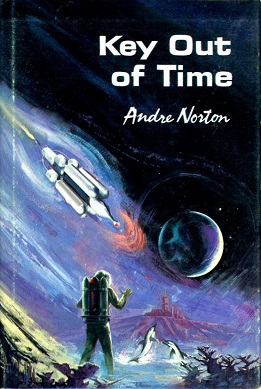
Key Out of Time is a science fiction novel by American writer Andre Norton, set on the world, Hawaika, that appears to be a tropical paradise.
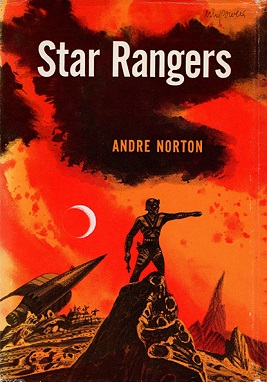
Star Rangers, also known as The Last Planet, is a science fiction novel by the American author Andre Norton. The novel was published on August 20, 1953, by Harcourt, Brace & Company. This is one of Norton's Central Control books, which lay out the history of a galactic empire through events suggested by Norton's understanding of Terran history.
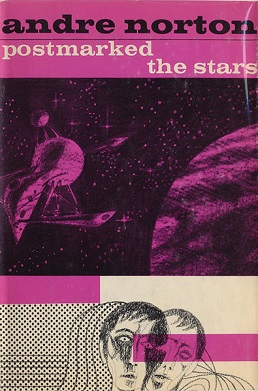
Postmarked the Stars is a science fiction novel by American writer Andre Norton, first published in the United States in 1969 by Harcourt, Brace & World. It is part of the series about the adventures of the interstellar tramp freighter Solar Queen and her crew.


















